A Broadwell Retrospective Review in 2020: Is eDRAM Still Worth It?
by Dr. Ian Cutress on November 2, 2020 11:00 AM ESTGaming Tests: Borderlands 3
As a big Borderlands fan, having to sit and wait six months for the EPIC Store exclusive to expire before we saw it on Steam felt like a long time to wait. The fourth title of the franchise, if you exclude the TellTale style-games, BL3 expands the universe beyond Pandora and its orbit, with the set of heroes (plus those from previous games) now cruising the galaxy looking for vaults and the treasures within. Popular Characters like Tiny Tina, Claptrap, Lilith, Dr. Zed, Zer0, Tannis, and others all make appearances as the game continues its cel-shaded design but with the graphical fidelity turned up. Borderlands 1 gave me my first ever taste of proper in-game second order PhysX, and it’s a high standard that continues to this day.
BL3 works best with online access, so it is filed under our online games section. BL3 is also one of our biggest downloads, requiring 100+ GB. As BL3 supports resolution scaling, we are using the following settings:
- 360p Very Low, 1440p Very Low, 4K Very Low, 1080p Badass
BL3 has its own in-game benchmark, which recreates a set of on-rails scenes with a variety of activity going on in each, such as shootouts, explosions, and wildlife. The benchmark outputs its own results files, including frame times, which can be parsed for our averages/percentile data.
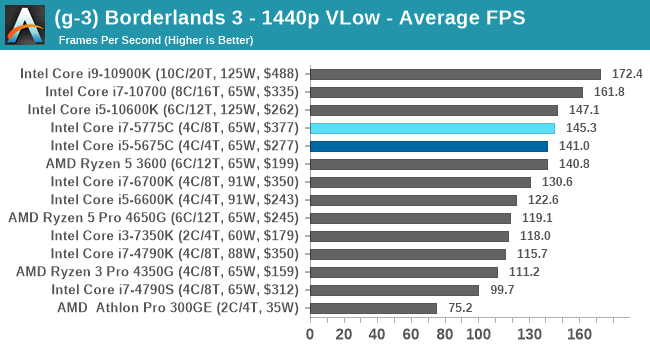
| AnandTech | Low Res Low Qual |
Medium Res Low Qual |
High Res Low Qual |
Medium Res Max Qual |
| Average FPS | 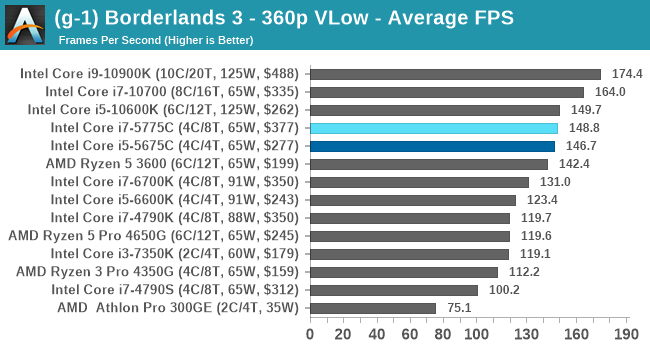 |
 |
 |
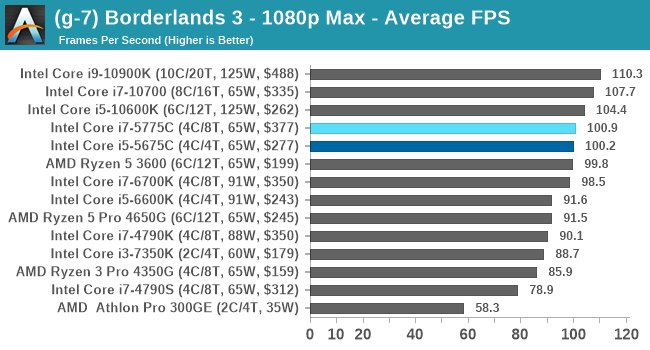 |
| 95th Percentile | 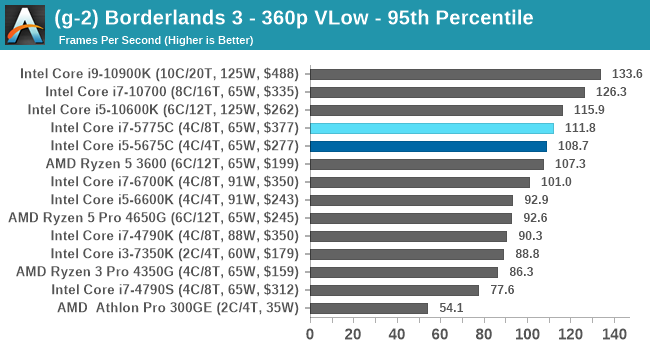 |
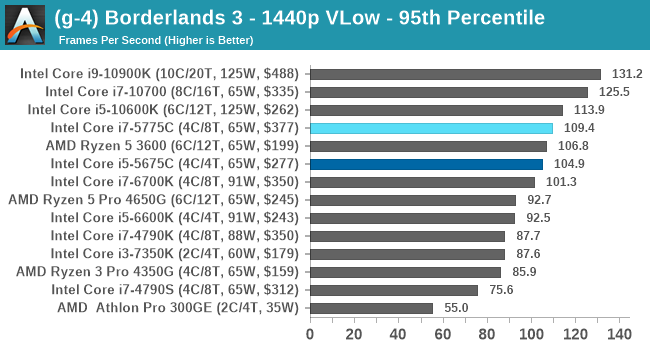 |
 |
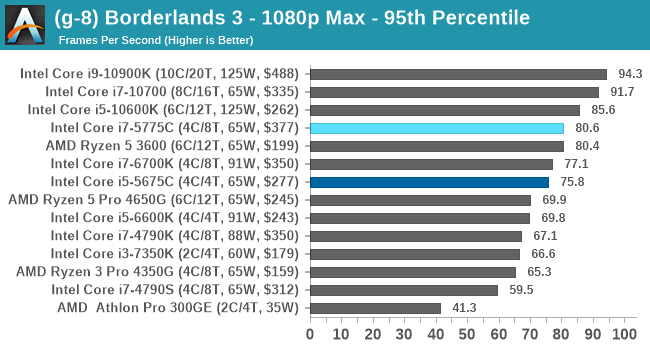 |
Another consistent test, with the Core i7 and Core i5 sitting just behind Intel's Comet Lake i5.
All of our benchmark results can also be found in our benchmark engine, Bench.











120 Comments
View All Comments
bernstein - Monday, November 2, 2020 - link
GDDR6 would be ideally suited as an L4 CPU cache... it has >500GB/s throughput and relatively low cost...e36Jeff - Monday, November 2, 2020 - link
Sure, if you build a 256-bit bus and somehow cram 8 GDDR6 chips onto the CPU package. You'd also be losing 30-40W of TDP to that.This is an application that HBM2 would be much better for. You can easily cram up to 4GB into the package with a much lower TDP impact and still get your 500+GB/s throughput. The biggest issue for this is going to be the impact of having to add in another memory controller and the associated die space and power that it eats up.
FreckledTrout - Monday, November 2, 2020 - link
This is also how I see it playing out. Certainly by the time Intel/AMD switch to using GAAFET maybe before. You just need a couple die shrinks that bring densities up and power down.bernstein - Monday, November 2, 2020 - link
scratch that, GDDR6 has much too high latency...stanleyipkiss - Monday, November 2, 2020 - link
The 5775C was ahead of its time. Don't know why they didn't go down that rabbit hole (of increasing the size with each gen)hecksagon - Monday, November 2, 2020 - link
Adding an extra 84mm2 of die area is a recipe for margin erosion, especially when the benefit is situational.CrispySilicon - Monday, November 2, 2020 - link
Well, I use a 5775C for my main home PC (using it now) and it's more than that. Broadwell was designed for low power. It doesn't run well over 4Ghz and it's not made to.My rig idles at about 800mhz, clocks up to 4ghz on all cores, 2ghz on the edram, and 2ghz on DDR3L (overclocked 1866 hyperx fury), yes, 3L, becuase THAT'S where the magic happens. Low power performance.
I've also used TridentX 2400CL10 modules in it, not worth the higher voltage.
I'm going to upgrade finally next year. CXL and DDR5 will finally retire this diamond in the rough.
Retest with nothing in the BIOS changed except the eDRAM multiplier to 20 and see what happens.
Notmyusualid - Wednesday, November 4, 2020 - link
I usually run my Broadwell at 4.4GHz 24/7. However I have a failed bios battery so using the m/b default 4.0GHz overclock settings today. I don't let mine idle at low speeds, its High Performance mode only & I only boot the Desktop for gaming, or Software Define Radio. Both of which want GHz.Memory is Vengeance LED 3200MHz (CL15 & only stable at 3000MHz, XMP is not stable either), and 32GB is currently installed.
Given;
C:\Windows\System32>winsat mem
Windows System Assessment Tool
> Running: Feature Enumeration ''
> Run Time 00:00:00.00
> Running: System memory performance assessment ''
> Run Time 00:00:05.45
> Memory Performance 54386.55 MB/s
> Total Run Time 00:00:06.65
I think that is why my Broadwell missed out on any eDRAM - it wasn't necessary.
Dolphin runs about 35x seconds, as I remember it.
6950X running cool in 2020...
MrCommunistGen - Monday, November 2, 2020 - link
HA. Epic timing. Just starting to read this now, but I recently built a system with a Broadwell-based Xeon E3 chip I got for cheap on eBay. Mostly just because I wanted to play with a chip that had eDRAM and the price of entry for an i5 or i7 has remained pretty high.This will be a very interesting read!
alufan - Monday, November 2, 2020 - link
News all day as long as its about Intel so it seems on here said it before and have seen nothing since to change my mind